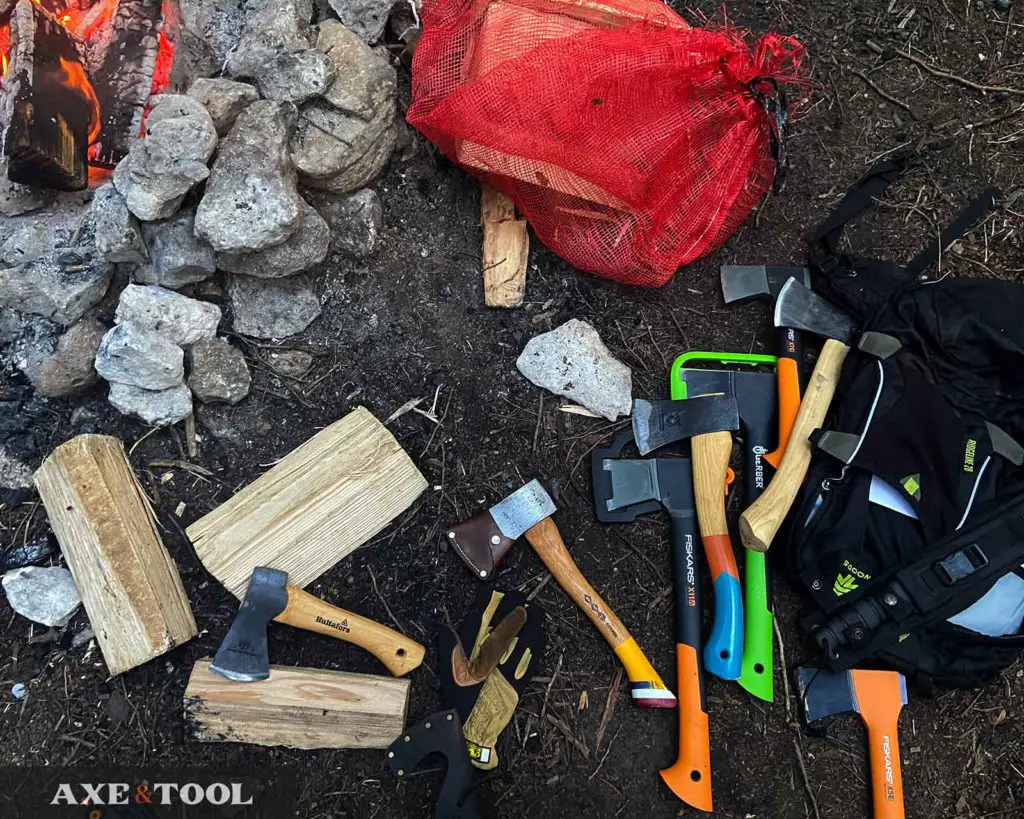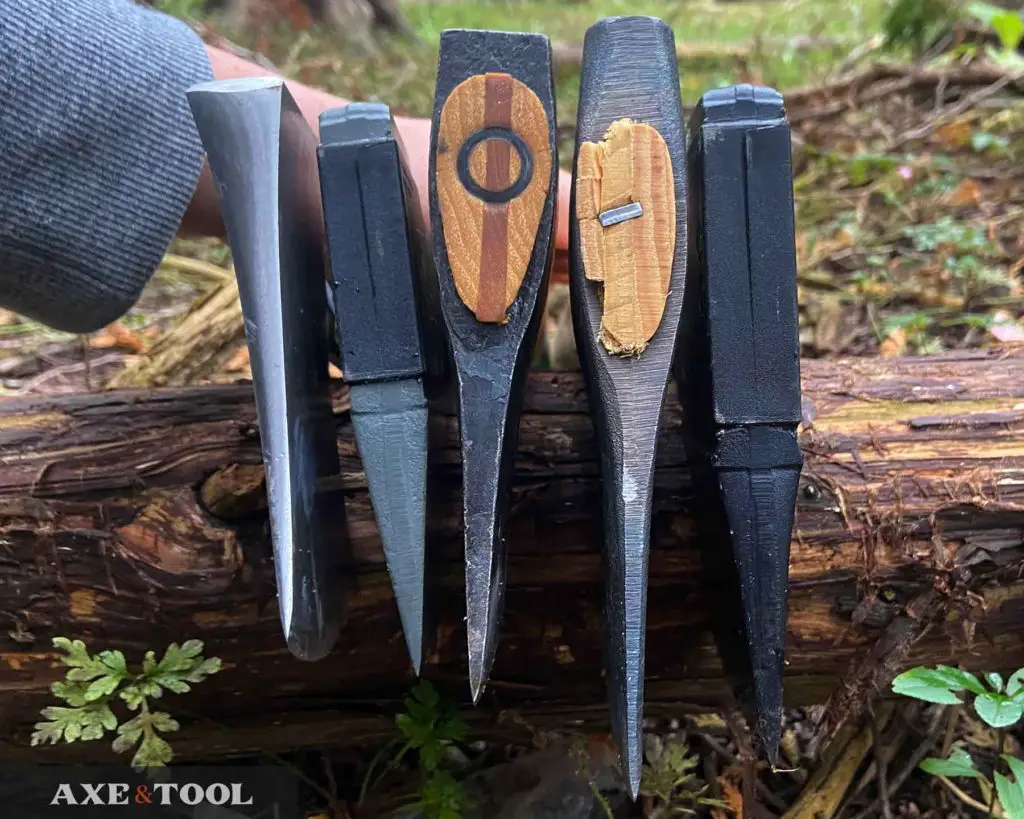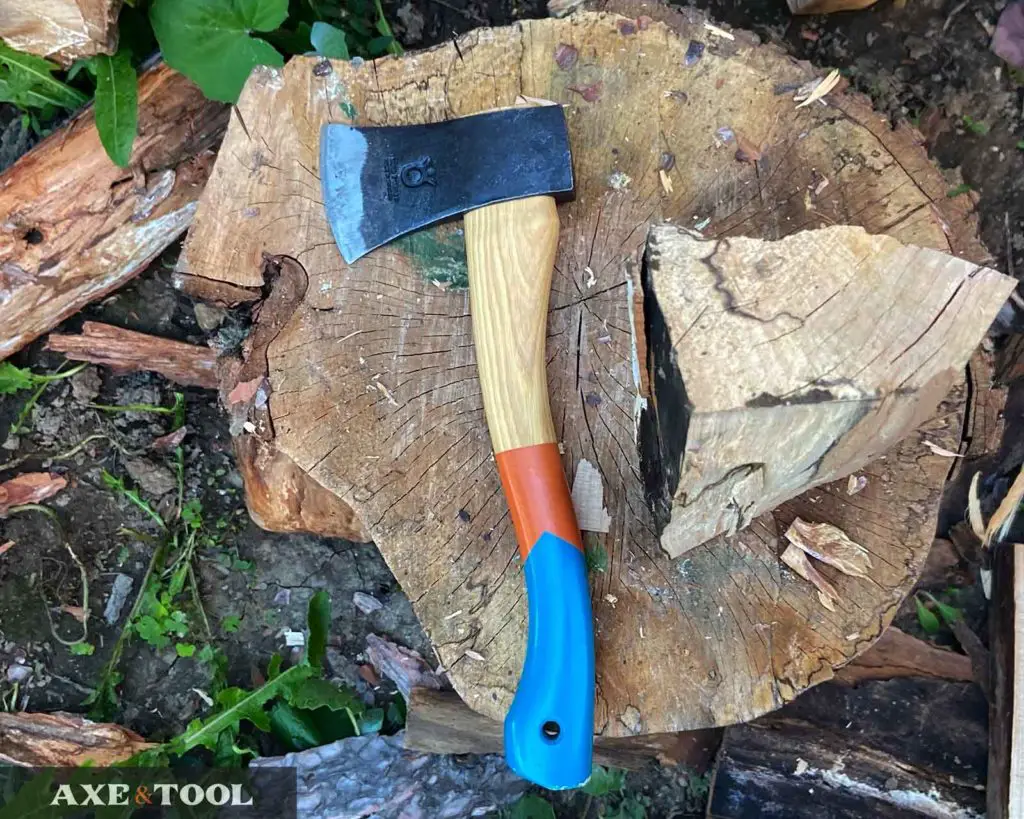How to Choose a Hatchet for Camping

If you are new to axes or camping, don’t start with an expensive hatchet. You should learn some of the skills with a good but affordable option. It’s painful to chip an edge or overstrike the handle on a $150 axe (I’ve done both).
But there is more than price to consider. The materials, head shape, and minor details can impact which tasks the hatchet will be best suited for.
Hatchet Handle Material
There are 3 options for handle material; wood, composite, or steel.
Wood handles
Traditional wood handles are my favorite (bias upfront). They feel natural in hand, absorb shock, and the texture of the wood offers more dexterity and control.
Even a value hatchet handle can be shaped, sanded, and oiled to perfection.
With a little care, they can last for decades. Store them indoors and occasionally oil the handle and you are set. But without any care at all, they will eventually have issues (we’re talking years). I have a couple of easy steps to keep your axe or hatchet from loosening here.
Composite handles
Composite handles are durable and need no maintenance. Overstrikes don’t matter and you can leave them in your shed or car year-round without issue. They will never loosen or break.
If you just want something that works and needs no second thought – go with a composite axe.
The compromises are they are a little slick, can be harder on the hands, and are a little cold to the touch in winter.
Steel handles
Full disclosure – I don’t like steel-handled axes. A lot of people do and they have a long legacy. So if you like them, you aren’t alone. They are also basically indestructible but they have a few drawbacks (in my opinion).
They have heavier handles, fewer grip options, more vibration, and are very cold to touch in the winter.
Hatchet Head Shape

There is a wide range of general-purpose axe heads that can do everything, but lend themselves better to certain tasks:
Stout axe heads that with a shorter cutting edge and wider profile are best for splitting wood. The force is concentrated in the bit and the wedge shape spreads the wood apart quickly.
Heads with long thin blades can still split kindling, but it takes more force to drive the entire blade through the wood before the eye finally starts to spread the grain. But these thinner blades are better suited to chopping, carving, and more detailed tasks.
Splitting hatchets are also available that have a specially designed head. They have heavy flared heads that pop the firewood apart easily. If you don’t care about the craft side of things, you can get some really good splitting hatchets that will offer more one-hit splits.
Details and Extras
There are always details that you should be aware of, but they may not be deal-breakers.
Like most axes come with a sheath, but not all of them. And most axes and hatchets (even decent ones) don’t come super sharp.
They will come usably sharp for splitting and basic chopping, but affordable axes aren’t shaving sharp.
A few hatchets also have a specially hardened poll (back of the head) designed to be used as a hammer.
Best Entry-level Camp Hatchets

I’ve taken many different hatchets camping over the years, and have some favorites. On my last family outing, I decided to bring a bunch for testing and comparison.
Wood handled
1. Husqvarna 13″ Wood
2. Council Tool Flying Fox
Composite
1. Fiskars
2. Husqvarna 13″ composite
Metal handle
1. Estwing
Husqvarna 13″ (wood) axe is a great beginner hatchet

This hatchet is cheap, made well, and comes with a leather sheath. Husqvarna axes have a reputation for quality above their price point. The head is a basic Yankee pattern with a nice-looking hand-forged finish. The blade has a versatile width that it’s good for splitting and chopping, and the shorted cutting edge concentrates the force.
They coming sharp enough to be put to work but may need a little work if you want to get into the camp craft side of things. But this hatchet is great to start learning all kinds of techniques and skills.
The wood handle is a little chunky, but it’s smooth, attached well, and free from varnish.
| Pros | Cons |
| Hard steel holds an edge | Rougher sharpen |
| Versatile head shape | Chunky handle |
| Leather Sheath | |
| Corrosion-resistant forged finish | |
Fiskars (or Gerber) is the easy choice

The Fiskars X7 is the 14″ hatchet, the head is a stout wedge shape that is perfect for splitting wood. It really pops the grain apart. This would be my starting point for a composite axe. It’s also ridiculously affordable at under $30.
They come sharp, the handle won’t break or loosen, no oiling, store them anywhere, they come with a sheath. Fiskars make it easy all around.
The Fiskars’ edge will dull quicker than the harder steel on the Husqvarna. If you are keen on simplicity they make a pull-through sharpener designed for their axes. See my article on the sharpener.
There is a larger 17″ model (the X10) which is sold under the Gerber brand in the US and Canada. The Gerber Freescape 17.5 has a larger and thinner head, more suited to chopping than splitting (but still capable).
There is also a dedicated splitting hatchet (the X11) read on for more on that hatchet.
| Pros | Cons |
| Comes sharp | Prone to edge chips |
| Very Affordable | |
| Durable handles | |
| Low maintenance | |
Council tool Flying fox is my choice for camp craft

I love this axe a lot, and it’s absolutely a great value camp axe. The thin blade is the only reason, I don’t have it as number one for a standard camping hatchet. It’s just not as efficient splitting as the first two, and that’s the main task.
It can still split kindling, and this would be my choice for anyone looking to get into bushcraft or camp craft activities.
The bit (blade) is long and thin, great for chopping carving, and shaping wood. The poll is hardened so it can be used as a real hammer. And it comes on a very slim and comfortable 16″ handle. It can even double as a throwing axe.
The “utility” line of Council tool axes are very affordable, but they don’t come with a sheath – which is a bit of a drawback.
| Pros | Cons |
| Comes sharp | No sheath |
| Hardened poll (Flying fox only) | Thin for splitting |
| Slim handle | |
| Long cutting edge | |
Estwing is an American classic

Estwing is an affordable, American-made classic. They come in 12″, 14″, and 16″ models, and are mostly indestructible (though rust can happen).
I own the 12″ Sportsman, but I would go for the 16″ camper if I had the choice. They come a little dull, but the blade is well-shaped. It’s very thin but the cheeks flare out so it’s still capable of splitting kindling.
These axes have a long legacy and will last a lifetime. However, I don’t love steel-handled axes and rarely use mine.
| Pros | Cons |
| Durable fixed handle | Limited grip options |
| Efficient head shape | Dull from factory |
| Nylon Sheath | |
Best splitting camp axe
If you don’t care about the extra craft side of things, you can get some really good splitting hatchets that will that can pop apart firewood with ease. Often one strike.

Fiskars X11 is the best campsite splitter
The Fiskars X11 is an excellent compact splitting axe. It’s 17″ long with a specialized splitting head that flares out to spread the wood. It can be used one or two-handed so it can cut tinder and split up to about an 8″ log.
The composite handle is tough but thin enough that you can easily choke up for finer work (making tinder). Accidental overstrikes (where the handle hits the log) don’t matter. And you can leave Fiskars axes in the trunk, or a shed all year and it will come out ready to work.
| Pros | Cons |
| Specialized splitting head | A little big for tinder |
| One or two-handed use | |
| Durable handle | |
| Low maintenance | |
| Light sheath | |
Husqvarna 13” Composite Axe is a compact splitter

The Husqvarna composite axe is similar to the Fiskars but differs in some key ways.
It has a larger wedge-shaped head, which makes it a better splitter of big/tough firewood, and has a hardened poll for hammering. The handle is more robust than the Fiskars so it can take a beating, but it’s less maneuverable for fine tasks.
But it comes quite dull, and costs almost twice as much. So you would need to sharpen it before any craftwork, or even tinder can be made effectively.
A good option for a dedicated splitting or tough emergency hatchet
| Pros | Cons |
| Heavy wedge head | Comes very dull |
| Re-enforced handle | Mediocre grip |
| Wide hardened poll | |
| Splits and Chops | |
Please comment below If I missed something or if you have any questions. I do my best to respond to everyone.
About the author:
About the author:
Jim Bell | Site Creator
I’m just a guy who likes axes. I got tired of only finding crap websites, so I set out to build a better one myself.
I’m also on Instagram: @axeandtool


Please correct use of the word “pole” (long cylindrical bar or stick) for “poll” — back side of the ax head.
I sure will – thanks for the catch. I am going to have to check all my posts, because I suspect it’s not the only time i’ve made that typo.